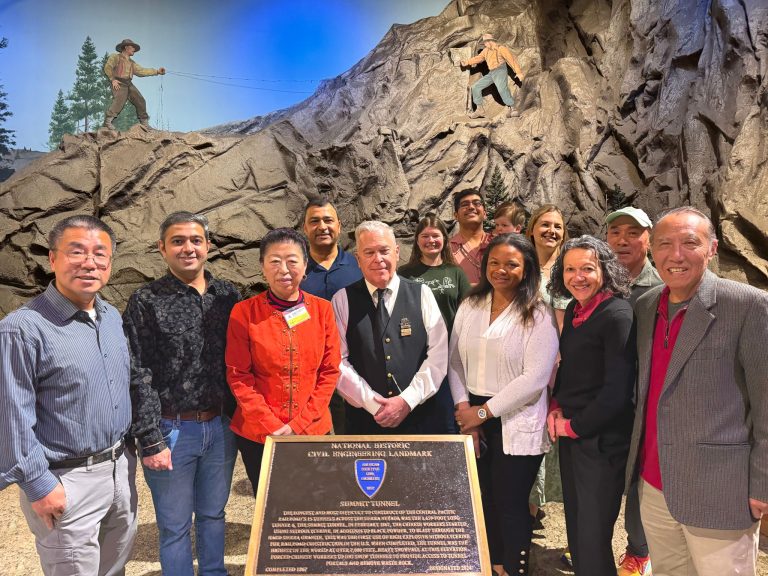
📍 Location: Colfax Heritage Museum – 99 Railroad St, Colfax, CA 95713
📅 Date: Saturday, June 21, 2025
🕙 Time: 11:00 AM – 12:00 PM
The Summit Tunnel, completed in 1867 as part of the first transcontinental railroad, is being officially recognized as a National Historic Civil Engineering Landmark. This remarkable feat of 19th-century engineering played a crucial role in connecting the country and advancing infrastructure development.
Join fellow ASCE members, engineers, historians, and local community members for this special dedication ceremony.
Event Schedule
🕙Dedication Ceremony (11:00 – 11:45 AM)
- Welcome & Introduction – Amit Joshi, ASCE Sacramento Section President
- Remarks – Feniosky Peña-Mora, ASCE National President
- Site History – Chuck Spinks, ASCE History & Heritage Committee
- History of a Chinese Family – Ray Chong, descendent of Chinese railroad worker for the Central Pacific RR
- Achieving Goals of the 1882 Foundation – Ted Gong, 1882 Project Foundation Executive Director
- Conclusion – Yaz Emrani, ASCE Region 9 Director
🍽️ No-host Lunch Social at the Main Street Pizza/The Basement on Main St. (46 N Main St, Colfax, CA 95713): 12:00 – 1:00 PM
Everyone is welcome—bring your colleagues, family, and friends for a day of reflection, history, and connection.
Kindly RSVP or contact us if you have questions. We look forward to seeing you there!
Historical Significance
- First use in the U.S. of Nitroglycerine high explosive for railroad construction in February 1867.
- First on-site manufacture in the U.S. of Nitroglycerine for construction, February 1867.
- Highest elevation tunnel in the world when completed in November, 1867 at approximately 7,030 feet.
For centuries, black powder was used as a blasting agent in construction to ease the burden on manual labor. It was used extensively in construction of early railroads, including in tunnels. It worked fine for most blasting needs, but was not very effective in blasting hard rock like granite, and was difficult to use in wet environments.
Although nitroglycerine, was invented in 1846, it was considered too dangerous for use in blasting. Alfred Nobel developed methods for manufacturing and handling of nitroglycerine in 1865 that initiated its limited use in construction in Europe. Nitroglycerine was much more powerful than black powder and was the beginning of the development of high explosives for construction. Noble invented nitroglycerine-based dynamite in 1867, but it was not widely used until the 1870s. The manufacture and use of nitroglycerine was never patented so it was in the public domain.
The nitroglycerine used on the Summit Tunnel was manufactured on-site by chemist James Howden. Howden’s Chinese assistants would pour the nitroglycerine into 1 1/8-inch diameter tin cartridges either 4, 5, or 6 inches long, and place in a wooden box. The most used were the 6” cartridges. They would take the cartridges to the tunnels where the Chinese tunnel crew would place them in 1 ¼ inch holes from 24” to 30” deep in the hard granite. Since nitroglycerin could not be exploded with flame like black powder, a black powder igniter was placed on the cartridge of nitroglycerine in the hole and a common safety fuse was attached. Electric firing with a battery for the ignitor was tried, but was found too cumbersome. The advantage of electric firing was that multiple concurrent blasts could be fired, whereas the common safety fuse only allowed one hole to be fired at a time.
With nitroglycerine, the progress of the tunnel headings went from 1.18 feet per day to 1.82 feet per day, an increase of 54%. For the bottoms, the rate went from 2.54 feet per day to 4.38 feet per day, an increase of 74%. The construction of a central shaft allowed 4 headings to be worked on simultaneously. Only one death was attributed to nitroglycerine, and that was an Irish foreman.
The elevation at the west portal of approximately 7,030 feet, was the highest in the world when the tunnel was completed in ate 1867. The Mont Cenis tunnel through the Alps was at only 3,680 feet. The challenge was dealing with the harsh winter at in the High Sierra. The average snowfall at Donner Pass is over 400 inches, with average depth in flat areas of 140 inches. The winter of 1866-1867 was the worst recorded winter in the Sierra up to that time. Gilliss noted in his ASCE paper that the accumulated snow at the summit was not gone until July 1867, with snow depths on the site at the site still at 15 feet in April and 11 feet in May. The snow drifts at the two portals were so deep that snow tunnels from 50 feet to 200 feet were required for access and removal of spoils.
